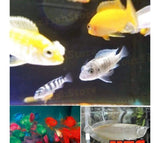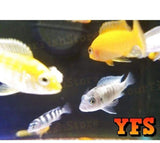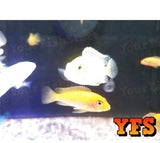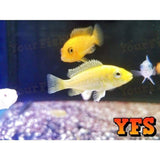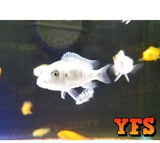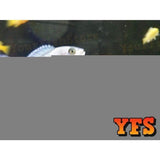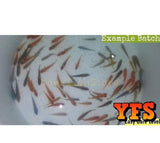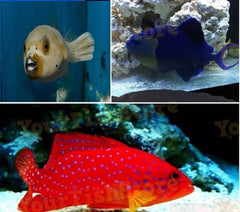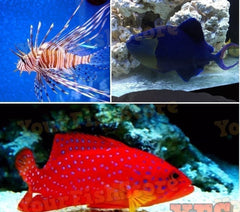X25 African Cichlid Assorted - X5 Assorted Jellybean Cic - X1 Silver Arowana Sml

PACKAGE INCLUDES:
x25 AFRICAN CICHLID ASSORTED
X5 ASSORTED JELLYBEAN PARROT CICHLID
x1 SILVER AROWANA SML
*********************************************************************
x25 ASSORTED AFRICAN CICHLID 1" Each
*HAND PICK AFRICAN CICHLIDS SM/MD SIZE
They will be scooped out our holding tanks. We cannot guarantee we will be able to scoop ALL different types, but we will try to get a good variety.
Minimum Tank Size: 30 gallons
Care Level: Easy
The African cichlids contain some of the most colorful of all freshwater fishes. The cichlids are an enormous family of fish and they offer the widest variety of body shapes and behaviors of all freshwater fishes.
This wonderful group is further complimented by their remarkable behavior, it is highly complex yet ritualistic. They are very active and many can be very personable, readily greeting their keepers and begging for food. These are the characteristics that make cichlids a favorite attraction for many hobbyists.
The African Cichlids seen in the hobby have a mix of fascinating characteristics and are a delight to keep. There are many colorful cichlids like the popular varieties of Peacock Cichlids. Others are highly prized for their unique habitat or behavioral characteristics. These can be seen in the goby cichlids, shelldwellers, featherfins, and popular Tropheus genus, to name a few.
Most of the favorite fish are moderate in size and very well suited to home aquariums. Some also reach an impressive size and are great specimens for a large show tank. Only a few are not really suitable for the home aquarium due to size.
*We keep our cichlids in a 500 gallon Tub and we generally scoop them out from an overhead view, so we are not able to get specific types.
Jacobfreibergi Peacock Cichlid
Julidochromis ani Cichlid Burundi
Kapampa N. Caudopunctatus Cichlid
Kennyi Maylandia Lombardoi Cichlid
Kigoma Callochromis Pleurospilus Cichlid
Labidochromis Chisumulae Cichlid
Lamprologus Meleagris Cichlid
Lamprologus Ocellatus Cichlid
Lemon Yellow Labido Caeruleus Cichlid
Limnotilapia Dardennii Cichlid
Livingstonii Cichlid
Moliro Red Band Troph Moorii Cichlid
Ndole Bay Tropheus Moorii Cichlid
Neolamprologus Brichardi Cichlid
Neolamprologus Cylindricus Cichlid
Neolamprologus Olivaceous
Neolamprologus Tretocephalus Cichlid
Nkhata Orange Petro. Tridentiger Cichlid
Nyassae Peacock Cichlid
O.B. Labeotropheus Fuelleborni Cichlid
Orange Blotched Peacock Cichlid
Otopharynx Tetrastigma Cichlid
Polystigma Cichlid
Pseudotropheus Acei Cichlid
Pseudotropheus Elongatus Cichlid
Red Empress Cichlid
Red Fire Queen Peacock Cichlid
Red Frontosa Cichlid
Red Labeotropheus Trewavasae Cichlid
Red Peacock Cichlid
Red Petrochromis Cichlid Bulu Point
Red Zebra Cichlid
Redfin Copadichromis Borleyi Cichlid
Redtop Labidochromis Hongi Cichlid
Redtop Ndumbi Pseudo. Persipax Cichlid
Ruby Crystal Peacock Cichlid
Socolofi Cichlid
Strawberry Peacock Cichlid
Sunshine Peacock Cichlid
Taeniolethrinops Furcicauda Cichlid Wild Female
Taiwan Reef Protomelas Steveni Cichlid
Telmatochromis Vittatus Cichlid
Tropheus Duboisi Cichlid
Venustus Cichlid
Yellow Band Tropheus Moorii Cichlid
Yellow Blaze Copadochomis Cichlid
Yellow P. Elongatus Cichlid Mara
Zebra Chilumba Cichlid Maison Reef
Zimbabwe Rocks Otoph. Lithobates Cichlid
********************************************************
X5 ASSORTED JELLYBEAN PARROT CICHLID - FRESHWATER FISH LIVE - FREE SHIPPING
They will be scooped out our holding tanks. We cannot guarantee we will be able to scoop ALL different types, but we will try to get a good variety.
*THIS ORDER IS FOR FIVE JELLY BEAN CICHLIDS
Tank Size Required
30 Gallons Minimum A good rule of thumb is 30 gallon for one and 10 more gallons for each additional Blood Parrot. As with any fish, the bigger the tank the better.
Size and Growth
6 - 9" (15 - 24cm) Blood Parrots grow slow when compared to other Central American Cichlids or Flowerhorn. Once they hit 4-5" their growth slows further. They typically can live anywhere from 5 - 15 years depending on the care given to them and other genetic factors. When Blood Parrots are small they may show a tan/brown body color with black spots near the tail. These are simply juveniles that should change to orange/yellow as they grow.
Water Conditions
Temperature: 76 - 86F (24 - 30C) pH: 6.0 - 8.5 Temperatures should be between 76 - 86F (24 - 30C) but the ideal temperature should be between 82 - 84F (26 - 29C). Temperatures lower than 80F (24C) seems to cause them to be more reclusive and cause the color to be more pale. The ideal pH should be between 7.0 - 8.0.
Feeding
Blood Parrots enjoy pelleted foods with occasional Blood Worm and Shrimp treats. A smaller pellet size should be used due to their mouths. Recommended pellet brands are Hikari Cichlid or New Life Spectrum Cichlid/Cichlasoma Formula 1 - 3mm depending on the size of the fish. Feeding can sometimes be tricky as some have more deformed mouths than others or gill curl or other gill deformities. If the Parrot has trouble feeding from the surface then it is recommended to switch to a sinking pellet. Thawed shelled peas should be fed once a week to add roughage to the diet to help prevent Swim Bladder problems.
Social Behavior
Blood Parrots, especially when young, can be very shy and reclusive. Its typical for them to hide when you first bring them home to hide and/or be very skittish and can take a few weeks for them to adjust to their new surroundings. Some ways for you to help them adjust is to make sure they have several hiding spots and adding some dither fish. Removing hiding spots will only make them more shy and could take longer for them to adjust. Blood Parrots like all Central American Cichlids are territorial and not typically suitable for small community fish. If it fits in their mouth or close then they will try to eat it. Given the proper tank Blood Parrots typically get along fine with most Central and Southern American Cichlids although large overly aggressive cichlids should be avoided as tankmates or house with caution. Due to Blood Parrots deformed mouths they cannot cause much damage to other fish although recently low quality Blood Parrots are being produced to sell at cheaper prices that do not have the deformed mouth and they can do damage.
Health Issues
Stress Spots: This is usually mistaken for Neascus (Black spot disease). Blood Parrots sometimes get Stress Spots which are black splotches on the body or fins and this is caused by stress. This is typically present you bring them home but can also show up when in cases of shyness, bullying, breeding, illness, or sometimes nothing at all. The splotches will usually disappear after awhile once the problem is taken care of.
***********************************
x1 SILVER AROWANA SML OSTEOGLOSSUM BIRCIRRHOSUM FRESHWATER LIVE FISH
Approx 3"-4" Each
Minimum Tank Size: 75 Gallons
Care Level: Very Difficult
Water Conditions: 6.0-7.0 pH and Soft to Moderately Hard
Temperature: 75-82° F (24-27° C)
Maximum Size: 36 inches (91.5 centimeters)
The Arowana Osteoglossum bicirrhosum was first introduced into the aquarium hobby in 1912. This fish provides us with a glimpse into the past. It is one of only a few living examples of our ancient prehistoric world of the Jurassic age. Its scientific name is derived from the Greek terms "Osteoglossum" which means "bone-tongued" and "bicirrhosum" which means "two barbels". So basically this as a bony-tongued fish with two barbels. Because of its coloration it is also known as a Silver Arowana. It has a few different spellings, so it can be found as a Silver Aruana, Silver Arawana, and Silver Arrowanas. But all these common names are representative of the same species.
The Silver Arowana is one of the most interesting fish and it can get very large. It is a long fish with a fluid, almost snake-like swimming motion. A maximum sized specimen would reach up to 47 inches (120 cm) in length and need an aquarium of at least 4 feet wide and 4 feet long just to turn around. A specimen of that size is pretty rare in the aquarium, generally they are smaller with 24 to 30 inches (60 - 78 cm) being a good sized Arowana. It is basically a silver fish, but its scales are very large. As this fish matures the scales develop an opalescent effect that will reflect blue, red, and green highlights. This has led to the nickname "Dragonfish" when seen in the wild.
One of the most curious characteristics of this fish are its mouth. It opens in three pieces and looks similar to a loading barge, definitely indicative of its predatory nature and appetite. The two distinctive barbels at the tip of the lower jaw are great sensory devices. With them, it can sense and capture prey on the surface of the water, even in total darkness. Its eyesight is also remarkable. With a keen vision, this fish can see above the surface, spotting and leaping out of the water to strike insects and birds from over hanging tree branches. This has lead to still another nickname for this fish, the "Water Monkey".
Though they can be kept together when small, larger specimens are best kept singly or with other species of larger fish. They are a predator and will eat small fish. But on a positive note, they can become quite tame and take food from your fingers.
These fish are excellent jumpers and very strong, so make sure the top of the aquarium is securely covered. The Arowana will prefer an aquarium with a fine gravel bottom, planted loosely with hardy plants, and have open areas on the top to swim.
For best results they should be provided with a highly varied diet. Shrimp, prawns, mealworms, crickets, centipedes, krill and frogs are all suitable foods, though any sharp pieces should first be removed and live animals should be quarantined first to avoid the introduction of parasites.
Arowanas enjoy eating smaller fish but should not be fed these too often, as a build-up of fat in their bodies can lead to health problems. Many arowanas will take pellet food, but this is not sufficient on a daily basis.
Individual preferences vary, so be ready to experiment to see what your arowanas like.
Because arowanas are so active and tend to swim fast, you should avoid having any sharp objects in your aquarium on which they might injure themselves. Fast flowing water will keep them in better condition as it will discourage them from rubbing against the glass.
Arowanas in aquariums often suffer from protruding, drooping eyes due to looking downwards a lot, which they should not do in the wild.
A good way to avoid this is to keep a brightly coloured ping pong ball floating on the surface of the water. This will distract them sufficiently to keep their eyes in good condition and they'll enjoy playing with it, giving you something extra to enjoy watching.
Arowanas are extremely difficult to breed in captivity, especially in an aquarium. They spend months courting to develop pair bonds and spawn just once a year. If they do breed successfully, the male will protect the eggs, and later the fry, in his mouth. However, the female may eat them, so it is best to separate her at this stage.
QUESTIONS & ANSWERS
Have a Question?
Be the first to ask a question about this.


